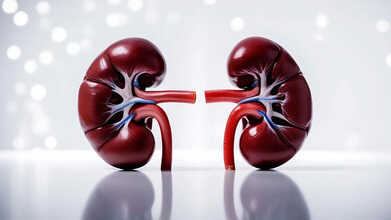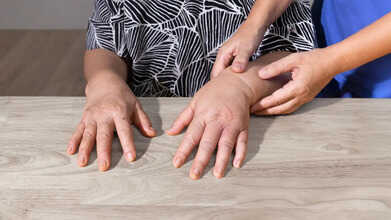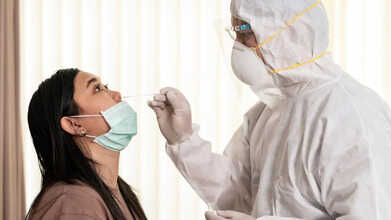- Health Conditions A-Z
- Health & Wellness
- Nutrition
- Fitness
- Health News
- Ayurveda
- Videos
- Medicine A-Z
- Parenting
- Web Stories
Joe Biden Undergoes Surgery To Remove Skin Cancer Months After Prostate Cancer Diagnosis

Credits: Delaware News Journal
Joe Biden was recently seen leaving a Delaware church with a visible scar on his forehead. Soon after, his office confirmed he had undergone Mohs surgery, a widely used procedure to remove skin cancer. The surgery, performed quietly, marks yet another chapter in the former president’s long history with cancer.
This comes just months after Biden revealed a far more serious health challenge, an aggressive form of prostate cancer that had spread to his bones. While his spokesperson reassured the public that he is recovering well, the combination of two cancers in less than a year has reignited questions about cancer risk, genetics, and what it means when an individual faces multiple cancer diagnoses.
Prostate cancer remains one of the leading causes of cancer death in men, with about 1 in 8 men diagnosed in their lifetime. African American men face the highest risk.
Skin cancer, particularly basal cell carcinoma, is the most common cancer in the United States, with millions of cases diagnosed each year. Most are not deadly, but repeated exposure and recurrence are common.
Also Read: RFK Jr., at vaccine hearings, claims ‘We Were Lied To About Everything Around COVID.’
Medical experts emphasize that both cancers are highly influenced by early detection. Prostate-specific antigen (PSA) blood tests, regular skin checks, and prompt evaluation of symptoms like urinary changes or new skin lesions remain essential.
According to his team, Biden’s procedure was Mohs micrographic surgery, often used for basal cell carcinoma, the most common type of skin cancer. The technique removes thin layers of cancerous tissue until only healthy cells remain. It is effective and carries a high cure rate when the cancer is detected early.
Biden has had skin cancer treated before. In 2023, during a routine physical, doctors removed a lesion from his chest that was also identified as basal cell carcinoma. At that time, his physician Dr. Kevin O’Connor confirmed that “all cancerous tissue was successfully removed” and that no further treatment was required.
While skin cancer is common and generally treatable, its recurrence underscores the need for ongoing surveillance. For someone in Biden’s position—82 years old and already facing another major cancer diagnosis—the surgery is more than routine maintenance; it is a reminder of his heightened vulnerability.
Prostate Cancer Spread to the Bones
In May, Biden disclosed that he had been diagnosed with a metastatic form of prostate cancer. His team explained that the cancer was “hormone-sensitive,” meaning it could respond to treatment that suppresses or blocks testosterone, which fuels prostate cancer growth.
Prostate cancer is the second most common cancer in men worldwide, and its aggressiveness varies. Many men live for years with slow-growing forms. But when it spreads to bones, as in Biden’s case, it becomes significantly harder to control. Treatment focuses on slowing progression, relieving symptoms, and maintaining quality of life.
Biden’s diagnosis brought bipartisan responses: sympathy and calls for resilience from both Democrats and Republicans, mixed with political scrutiny over whether the timing of his disclosure was delayed. For the public, it highlighted not only the seriousness of prostate cancer but also the importance of regular screenings and early detection.
History Of Cancer in the Biden Family
Cancer is not new to the Biden family. Jill Biden, the former first lady, had two basal cell carcinomas removed in 2023. Their son Beau Biden died of brain cancer in 2015, a loss that has profoundly shaped Biden’s public and private life.
In a post following his prostate cancer announcement, Biden wrote, “Cancer touches us all. Like so many of you, Jill and I have learned that we are strongest in the broken places.”
The frequency of cancer diagnoses within his family adds weight to a question many readers have: does family history of cancer increase the risk of other cancers?
Are Skin and Prostate Cancer Linked?
Medically, basal cell carcinoma and prostate cancer are not directly connected. One develops with too much sun exposure and DNA damage to skin cells; the other occurs in the prostate gland, based on age, hormones, and occasionally genetics. However, a previous history of one cancer does increase general alertness for others. Physicians point out that:
Age is the single best predictor. At age 82, Biden's immune system is less capable of fixing DNA damage that can set up cancers.
Family history might contribute to clustering of cancers, but usually of different kinds.
Lifestyle and environmental exposure—tanning and diet, for instance—are cumulative risks that can add up over a lifetime.
In short, although Biden's skin and prostate cancers are not medically related, his age, genetic makeup, and past history of cancers individually put him in a high-risk group.
Multiple Cancers in One Lifetime
Joe Biden's case represents a reality more and more people live with: surviving a first cancer does not erase the possibility of a second. As life expectancy rises and treatments improve, it is becoming increasingly normal for patients to experience two, even three separate cancers in a lifetime.
Family history counts: A robust history of any kind of cancer can increase risk for several kinds.
Screening saves lives: Prostate exams and dermatology checks can identify cancers in their earliest stages, when they are simplest to treat.
Prevention is key: Sunscreen, healthy foods, exercise, and not using tobacco and alcohol all reduce overall cancer risk.
Can Having One Cancer Increase Your Risk of Another?
Most people ask if beating one kind of cancer makes them more susceptible to others. The reply is: having had cancer can raise overall risk, but it varies with genetics, treatment, age, and lifestyle.
1. Genetic Predisposition
Some cancers have inherited mutations that target several organs. Examples include:
- BRCA1/BRCA2: Raise risk for breast, ovarian, prostate cancers.
- Lynch syndrome: Increases risk of colorectal, endometrial, and other cancers.
- Li-Fraumeni syndrome (TP53 mutations): Substantially increases the risk for a variety of cancers at an early age.
Here, one mutation can cause an individual to develop more than one form of cancer in his/her lifetime.
2. Effects of Previous Cancer or Treatment
Some cancer therapies, such as chemotherapy and radiation, will modestly increase the risk of developing a subsequent cancer years down the road. This is typically balanced against the cure for the initial cancer.
3. Shared Risk Factors
Aside from a genetic connection, age, lifestyle, and environmental exposures can increase the risk for more than one cancer:
- Smoking and alcohol consumption
- Sunlight exposure and skin damage
- Obesity or diet
- Chronic inflammation or compromised immune system
4. Surveillance Matters
Patients who have already had one cancer are usually followed more closely, which results in the detection of another cancer at an early stage. Routine checkups, screenings, and self-exams are essential.
Having survived one cancer does not mean one is safe from others, but prevention, awareness, and early detection drastically lower risk. Such instances as Joe Biden's, where prostate cancer preceded skin cancer, underscore how a lifetime of vigilance and a doctor's guidance is necessary for a cancer survivor.
Hyderabad Faces Surge in Mysterious Kidney Disease Among Healthy Youth, Study Finds

Credits: Canva
A chronic kidney disorder of unknown origin, referred to as Chronic Kidney Disease of unknown etiology (CKDu), is leading to kidney failures in Hyderabad and nearby districts of Telangana, alarmingly affecting younger adults who are economically active and have no prior history of diabetes or high blood pressure.
A team of senior nephrologists from Osmania General Hospital (OGH) and Apollo Hospitals studied 75 patients and published their findings in the Indian Journal of Nephrology (August 2024). The study revealed that while the disease resembles the mysterious kidney failures reported in Andhra Pradesh and other states, it shows a distinct, city-specific pattern of risk in Hyderabad.
Mysterious Kidney Disease In Hyderadabad
A mysterious kidney condition, called chronic kidney disease of unknown etiology (CKDu), is increasingly being reported among younger, non-diabetic residents in Hyderabad and nearby districts of Telangana, a study led by nephrologists reveals. Unlike traditional CKDu cases, which are often associated with agricultural work and heat exposure, this urban group largely comprises small business owners and service-sector workers with no farming history.
“Our research confirms the presence of the CKDu phenotype in Telangana, beyond the established hotspot regions, showing that an agricultural background is not required for the disease to develop,” said Dr. Manisha Sahay, Head of Nephrology at OGH and lead author of the study.
While CKDu in other regions is typically linked to strenuous farm labor and heat exposure, clinical data from OGH indicate that different, non-occupational factors may be driving the disease in younger, economically active individuals with no farming history. The condition progresses silently, often only producing symptoms once the kidneys are severely damaged, making urgent treatment at hospitals like Osmania General Hospital necessary.
What Is Chronic Kidney Disease Of Unknown Etiology?
Chronic kidney disease of unknown etiology (CKDu) is a type of chronic kidney disease with no identifiable cause, commonly observed in agricultural communities in certain regions. It is believed to arise from multiple factors, including environmental exposures such as pesticides, heavy metals, heat stress, dehydration, and contaminated water. According to the International Society of Nephrology, CKDu is diagnosed when known risk factors for chronic kidney disease, such as diabetes and hypertension, are absent.
What Are The Possible Causes Of Chronic Kidney Disease Of Unknown Etiology?
While the exact cause of CKDu is not confirmed, researchers suggest several possible contributors. The disease is likely multifactorial, arising from a combination of factors rather than a single cause. Environmental toxins, including heavy metals, pesticides, and mycotoxins, are under investigation. Heat stress and repeated dehydration from strenuous work in hot climates may also damage kidney tubules. Other potential factors being studied include contaminated water supplies and viral infections.
Kidney biopsies of patients at OGH revealed widespread scarring and inflammation in the kidney’s filtering units, indicating that the disease starts silently in this critical compartment.
“The damage observed in these biopsies highlights the severe consequences of late diagnosis, a pattern seen consistently across all CKDu-affected regions. Since the disease remains largely asymptomatic in its early stages, patients often reach urban hospitals only when they urgently need dialysis or renal replacement therapy,” said Dr. Manisha Sahay, Head of Nephrology at OGH.
CKDu in Hyderabad Linked To Urban Lifestyles and Unregulated Herbal Remedies
“While globally, 60 to 80 percent of CKDu cases occur among agricultural workers, only 21.3 percent of the Hyderabad patients were involved in rice farming,” noted Dr. Manisha Sahay in the study. “This shows that the CKDu phenotype affects a broad range of individuals from non-agricultural backgrounds, including small business owners, service-sector employees, and urban residents.”
Adding to the concern, 40 percent of patients in the OGH study reported using unregulated alternative or herbal medicines. Researchers emphasize that this widespread local practice may represent a significant risk factor, highlighting the need for urgent public health investigations targeting local dispensaries and providers of traditional remedies.
Hand, Foot And Mouth Disease Strikes U.S. Day-Cares: What Parents Must Know

Credits: Canva
Health authorities have reported an active outbreak of hand, foot and mouth disease in Tennessee, impacting close to 200 children and staff members across multiple schools.
In its latest update on Monday, October 20, the Shelby County Health Department confirmed that 178 cases have been identified among students and staff in 31 schools and three daycare centers.
What Is Hand, Foot And Mouth Disease?
Health officials in Tennessee have issued a warning about a “highly contagious” illness spreading through several schools and childcare facilities.
The Shelby County Health Department confirmed in a recent statement that an outbreak of hand, foot and mouth disease (HFMD) has been detected across 31 schools and three childcare centers in the state.
According to the Centers for Disease Control and Prevention (CDC), hand, foot and mouth disease is a contagious viral infection that typically leads to fever, mouth ulcers, and a skin rash. Although it most often affects children under the age of five, people of any age can contract it. Symptoms usually persist for about a week to ten days.
The CDC explains that the virus spreads easily through droplets released when an infected person coughs, sneezes, or talks, as well as through contact with contaminated objects, surfaces, or fluid from blisters.
Symptoms Of Hand, Foot And Mouth Disease
Hand, foot and mouth disease (HFMD) usually develops in two stages. In the beginning, children often experience mild, flu-like symptoms such as a low fever, sore throat, runny nose, stomach discomfort, and loss of appetite. These early signs typically subside after a few days, followed by the appearance of an itchy rash on the palms, soles, elbows, knees, or buttocks, along with painful mouth sores that may form on or around the tongue, as per Cleveland Clinic.
These sores usually start as small pink spots before turning into blisters, and some children may also develop swollen lymph nodes in the neck. Most cases clear up within a week to ten days, though recovery can take longer in children under two years old.
What Causes Hand, Foot And Mouth Disease?
The illness is caused by viruses from the coxsackievirus and enterovirus families, which are commonly found in the mouth and digestive tract. HFMD is highly contagious, especially in the first few days of infection and often before the rash appears. While the blisters usually dry up within ten days, the virus can linger in stool for several weeks, meaning children may still spread it after symptoms have disappeared. The infection spreads through droplets released when an infected person coughs or sneezes, through direct contact with saliva, stool, or fluid from blisters, and by sharing utensils, cups, or towels. It can also spread by touching contaminated toys, surfaces, or doorknobs and then touching the mouth, nose, or eyes.
The Shelby County Health Department stated that it has been working closely with schools and childcare centers to track the outbreak and reduce the spread of the infection.
Dr. Bruce Randolph, Director and Health Officer of the department, noted that while most cases of hand, foot and mouth disease are mild, the virus can spread rapidly in group settings such as classrooms and daycare facilities. He advised parents to keep affected children at home until their fever has subsided, they are feeling better, and their mouth sores or blisters have started to heal.
Covid Could Be Causing Women To Age Faster; Here’s What Scientists Found

Credits: Canva
Covid could have accelerated arterial ageing by up to five years, with women experiencing the greatest impact, according to groundbreaking research. The study revealed that even mild Covid infections can stiffen blood vessels, a change normally linked to aging, which increases the risk of heart attacks, strokes, and other cardiovascular issues.
Encouragingly, vaccinated individuals generally showed less arterial stiffness compared to those who were unvaccinated. Study leader Professor Rosa Maria Bruno explained that many people affected by Covid continue to experience symptoms months or even years later, and researchers are “still uncovering how the virus triggers these lingering effects.”
The findings follow advice from an emergency doctor who recently highlighted a simple five-second test that could indicate heart problems.
Early Vascular Ageing Explained
Professor Bruno said: “We know Covid can directly impact blood vessels. This can lead to what we term early vascular aging, meaning your arteries are older than your actual age, increasing susceptibility to heart disease. Identifying at-risk individuals early is crucial to preventing heart attacks and strokes.”
How the Study Was Conducted
The research included 2,390 participants from 16 countries, including the UK and the US. Conducted from September 2020 to February 2022, participants were divided into four groups: those who never contracted Covid, those with recent mild infections who were not hospitalised, patients admitted to general wards, and the most severe cases treated in intensive care.
Stiffer Arteries Found Across All Covid Groups
The results were striking as all Covid-infected groups, including those with mild infections, showed stiffer arteries than people who had never been infected. Women were more affected than men, and individuals with long Covid symptoms like fatigue and shortness of breath showed the strongest vascular changes.
Reassuringly, vaccinated participants had less stiff arteries than unvaccinated ones, and over time, the Covid-related vascular ageing tended to stabilise or slightly improve.
How Arterial Stiffness Was Measured
Researchers determined vascular age by measuring how fast a blood pulse travels from the carotid artery in the neck to the femoral arteries in the legs, using a device to calculate carotid-femoral pulse wave velocity (PWV). A higher PWV indicates stiffer blood vessels and a higher vascular age. Measurements were taken six months after infection and repeated at 12 months. The analysis accounted for participants’ sex, age, and other cardiovascular risk factors.
The study found that PWV increased in women by 0.55 metres per second for mild Covid cases, 0.60 for hospitalised women, and 1.09 for those in intensive care. Researchers note that an increase of 0.5 metres per second is “clinically significant,” roughly equivalent to five years of vascular ageing, and raises the cardiovascular risk by 3 percent in a 60-year-old woman.
How Covid Affects Blood Vessels
Professor Bruno from Université Paris-Cité explained: “Covid-19 targets angiotensin-converting enzyme 2 receptors found on blood vessel linings. By entering these cells, the virus can cause vascular dysfunction and speed up arterial ageing. Our immune and inflammatory responses, which normally protect against infection, may also contribute to this damage.”
Covid Could Be Causing Women To Age Faster
Discussing the sex differences, she added: “Women generally mount a faster, stronger immune response, which helps defend against the infection. However, this same response can sometimes increase damage to the blood vessels after the virus has passed.”
The study found that Covid’s impact extends far beyond the respiratory system, silently affecting blood vessels and accelerating vascular aging, especially in women. While vaccination appears to offer some protection, awareness and early monitoring of heart health are important.
© 2024 Bennett, Coleman & Company Limited

